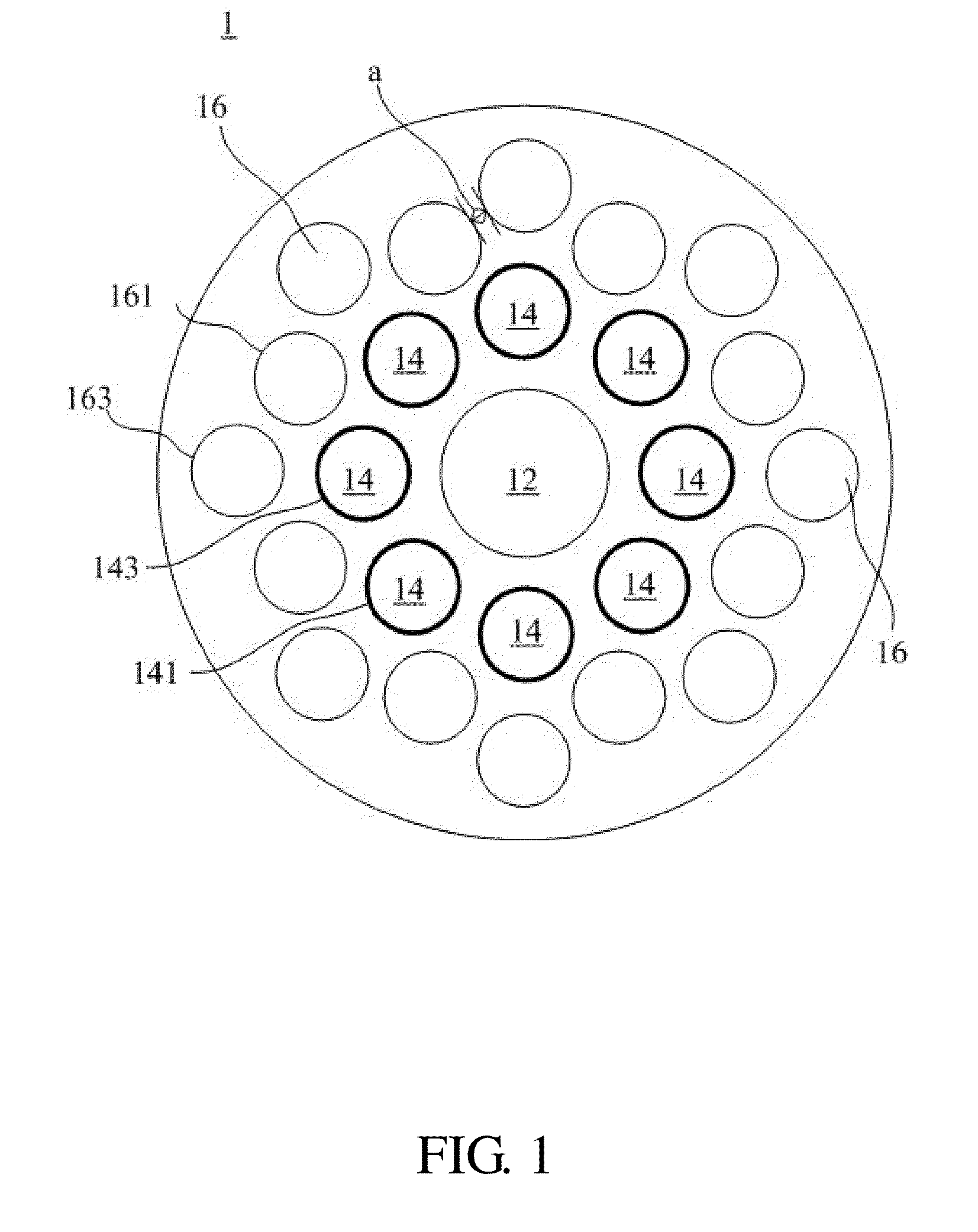Hydrogen generator and the application of the same
a generator and hydrogen technology, applied in the field of hydrogen generators, can solve the problems of low reaction rate, limited improvement effect, and degrading the commercial value of the resulting hydrogen-containing gaseous mixture, and achieve the effect of reducing co concentration
- Summary
- Abstract
- Description
- Claims
- Application Information
AI Technical Summary
Benefits of technology
Problems solved by technology
Method used
Image
Examples
example 1
Hydrogen Production Test at a Rate of 200 Liters / Hour (L / hr)
[0058]The cylindrical hydrogen generator 1 shown in FIG. 1 was used, where an aluminum alloy (Al-6061) was used as the first medium composing the hydrogen generator 1, and the hydrogen generator 1 has a diameter of about 51 mm, a depth of about 50 mm and a shortest distance a between individual channels of about 1 mm. The oxidation zone 12 located at the center of the hydrogen generator 1 has a diameter of about 13 mm and a depth of about 50 mm, and was filled with about 9 g of PBN oxidizing catalyst therein; the eight channels of the preheating zone 14 have a diameter of about 7 mm and a depth of about 50 mm; and the sixteen (16) channels of the reforming zone 16 have a diameter of about 7 mm and a depth of about 50 mm, and were filled with about 43 g of reforming catalyst JM-51 therein.
[0059]Methanol was used as the hydrogen-producing raw material, and a mixture of methanol and air was used as a fuel for the oxidizing rea...
example 2
Hydrogen Production Test at a Rate of 200 L / h
[0060]The same hydrogen generator and process as those of Example 1 were used to perform the methanol steam reforming reaction. However, brass (70% Cu, 30% Zn, with a thermal conductivity of about 121 W / m-K) was used instead as the first medium composing the hydrogen generator 1, and the supplying rate of methanol in the fuel was adjusted in such a way that hydrogen was produced at a rate of 200 L / hr. The temperature distribution of the hydrogen generator 1 was measured, thermal efficiency of hydrogen and the total methanol was calculated, and a CO content of the resulting hydrogen-containing gaseous mixture was analyzed, with the results being recorded in Table 1.
example 4
Hydrogen Production Test at a Rate of 200 L / hr
[0063]The rectangular hydrogen generator 2 shown in FIG. 2 was used, where an aluminum alloy (Al-6061) was used as the first medium composing the hydrogen generator 2. The hydrogen generator 2 has dimensions of about 55 mm×about 34 mm×about 50 mm and a shortest distance a between individual channels of about 1.5 mm. The oxidation zone 22 of the hydrogen generator 2 has a channel diameter of about 9 mm and a depth of about 50 mm, and was filled with about 4 g of PBN oxidizing catalyst therein; the preheating zone 24 has a channel diameter of about 7 mm and a depth of about 50 mm; and the reforming zone 26 has a channel diameter of about 9 mm and a depth of about 50 mm, and was filled with about 29 g of reforming catalyst JM-51 in the channels thereof.
[0064]As in Example 1, methanol and water were used as the hydrogen-producing raw materials, and a mixture of methanol with air was used as a fuel for the oxidizing reaction. Here, methanol u...
PUM
 Login to View More
Login to View More Abstract
Description
Claims
Application Information
 Login to View More
Login to View More - R&D
- Intellectual Property
- Life Sciences
- Materials
- Tech Scout
- Unparalleled Data Quality
- Higher Quality Content
- 60% Fewer Hallucinations
Browse by: Latest US Patents, China's latest patents, Technical Efficacy Thesaurus, Application Domain, Technology Topic, Popular Technical Reports.
© 2025 PatSnap. All rights reserved.Legal|Privacy policy|Modern Slavery Act Transparency Statement|Sitemap|About US| Contact US: help@patsnap.com



